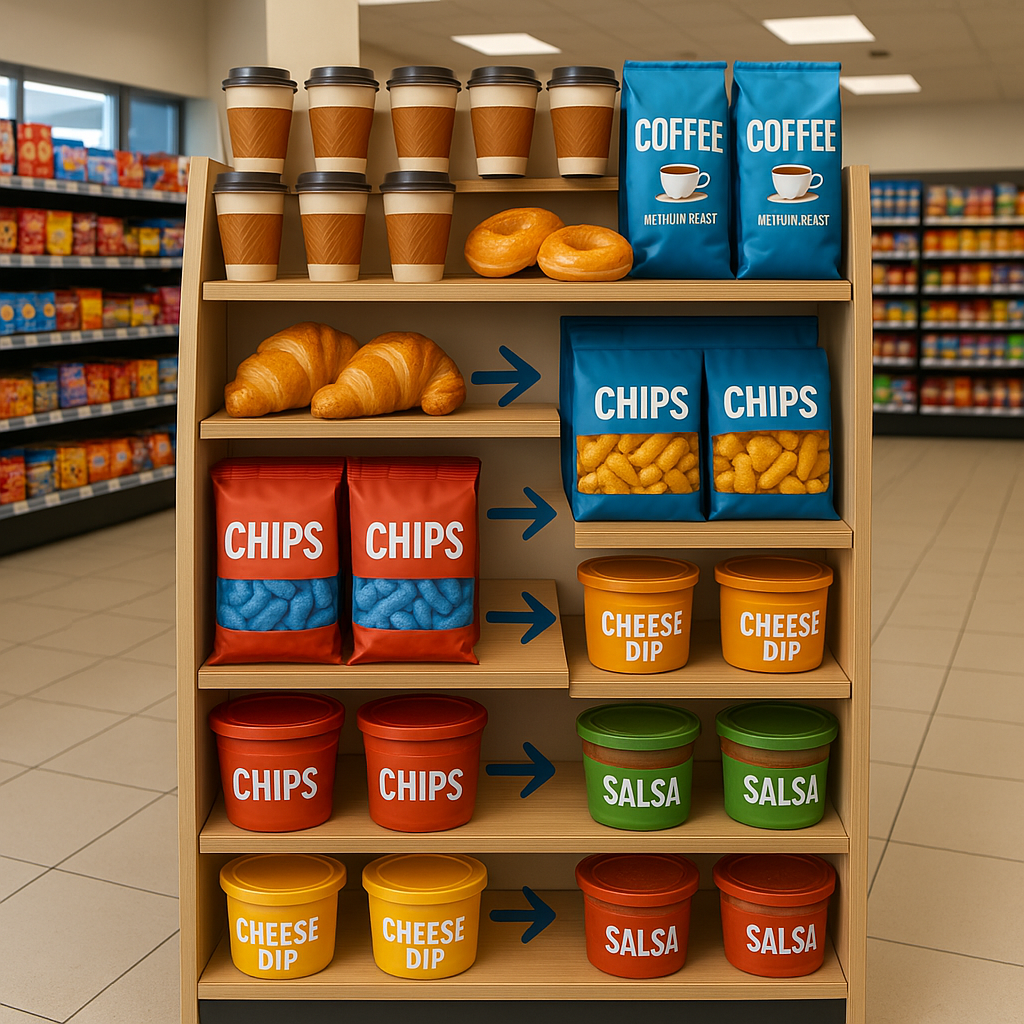The Power of Proximity: Mastering Cross-Merchandising in Your Convenience Store
Discover how strategic cross-merchandising can boost your convenience store sales. Learn effective techniques for pairing complementary products that enhance customer experience while increasing revenue.

The customer reaches for a bag of tortilla chips from your snack aisle. They turn, looking somewhat lost, then wander through three different sections before finally locating the salsa. By this time, they've forgotten about the guacamole they also wanted. They check out with just two items, while potential add-on purchases remain undiscovered on shelves across the store. This common scenario represents missed opportunities that thoughtful cross-merchandising can solve.
Cross-merchandising – strategically placing complementary products near each other – transforms shopping patterns from fragmented searches into natural discovery. When done right, this approach increases basket size, enhances customer satisfaction, and builds your reputation as a store that understands what shoppers truly want.
The Psychology Behind Effective Cross-Merchandising
Customers arrive at your store with varied shopping missions: the quick coffee stop, the lunch break dash, the evening snack run. Most enter with incomplete shopping lists – they know some items they need but haven't considered the complementary products that would enhance their experience.
Cross-merchandising bridges this gap by creating visual "solutions" rather than just offering products. A six-pack of beer positioned near pizza creates a meal solution. Disposable cups displayed near the energy drinks suggests a social sharing experience. Lighters placed by the register reminds tobacco purchasers of an essential accessory.
These strategic placements trigger recognition in customers' minds: "Yes, I need that too!" This reaction feels helpful to the customer rather than pushy, creating positive associations with your store.
Identifying Natural Product Pairings
Strong cross-merchandising starts with understanding which products naturally complement each other. Consider these relationship types:
Usage relationships: Items used together during consumption (chips and dip, hot dogs and buns, beer and pizza)
Occasion relationships: Products often purchased for the same event (energy drinks and breakfast sandwiches in morning, wine and chocolate in evening)
Problem-solution relationships: A product that solves a problem created by another (hand wipes near messy foods, aspirin near alcohol)
Seasonal relationships: Items that connect during specific times (sunscreen and bottled water during summer, hot chocolate and marshmallows in winter)
The most effective cross-merchandising focuses on relationships that feel natural to customers rather than forced or random connections.
Strategic Cross-Merchandising Locations
Several store locations offer particularly strong cross-merchandising potential:
End caps: These high-visibility locations work well for themed groupings (BBQ supplies, movie night essentials, breakfast solutions)
Register areas: Perfect for last-minute add-ons related to frequent purchases (lighters near tobacco, phone chargers near electronics, gum near coffee)
Cooler doors: The glass provides display space for shelf-stable items that complement refrigerated products (pasta displayed on doors containing pasta sauce)
Floor displays: Free-standing units can create complete solution centers (tailgating supplies, cold and flu remedies, car care products)
Hanging strips: Vertical merchandisers work for lightweight add-ons near primary products (drink mixes near bottled water, sauce packets near prepared foods)
Cross-Merchandising Success Stories
Certain cross-merchandising combinations consistently drive sales:
Chips positioned near sandwich materials Lemons and limes near alcoholic beverages Phone chargers near energy drinks Disposable utensils near prepared foods Ice cream toppings near frozen treats Single-serve coffee pods near travel mugs Batteries near seasonal items requiring power Hand sanitizer near fresh food displays
These pairings work because they represent genuine need connections rather than arbitrary placements.
Implementing Cross-Merchandising Effectively
Apply these principles to maximize your cross-merchandising impact:
Keep it logical. Customers should immediately understand the connection between paired items.
Maintain clear signage. Simple messages like "Perfect Together!" or "Don't Forget!" enhance the connection.
Rotate regularly. Change cross-merchandising displays based on seasons, local events, and purchasing patterns.
Track results. Monitor sales lift when items are cross-merchandised versus when displayed separately.
Consider customer flow. Place cross-merchandised items in natural traffic patterns rather than hidden corners.
Balance aesthetics. Avoid cluttered displays that create visual confusion or physical obstacles.
Train all staff. Ensure everyone understands the strategy behind each placement to maintain displays properly.
Cross-Merchandising as Problem-Solving
Beyond boosting sales, effective cross-merchandising solves real customer problems:
It reduces "forgotten item" frustration It saves time by grouping related needs It introduces customers to products they didn't know you carried It creates meal and activity solutions rather than just selling items It transforms routine shopping into a more satisfying experience
The best cross-merchandising feels like a helpful service rather than a sales tactic, building long-term loyalty while increasing short-term sales.
As you walk through your store tomorrow, which customer needs could you address more effectively through thoughtful product pairings, and how might these connections transform both their shopping experience and your bottom line?